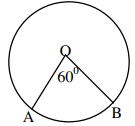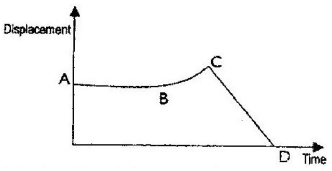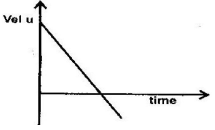Questions
- The diagram below shows part of the motion of a tennis ball, which is projected vertically upwards from the ground and allowed to bounce on the ground. Use this information to answer questions that follow.
- Describe the motion of the ball relating it to different positions of the ball along the following AB, BC, CDE.
- From the graph, calculate the acceleration due to gravity.
- How high does the ball rise initially?
- Explain why E is not at the same level as A.
- Sketch a velocity- time graph showing the motion of a ball vertically upwards with an initial velocity of u.
- Calculate the acceleration shown by the tickers-tape that was made using a ticker timer vibrating at 50Hz.
- What is the difference between speed and velocity?
- An object is projected vertically upwards at a speed of 15m/s. How long will it take to return to the same level of projection?
- A block slides off a horizontal table 4 meters high with a velocity of 12-m/s. Find:
- The horizontal distance from the table at which the block hits the floor.
- The horizontal and vertical components of the velocity when it reaches the floor.
- A particle initially at A moves along an arc AB of a horizontal circle of radius 4m and centre O.A is south of O and angle AOB is 600. Determine the displacement AB.
- The figure represents dots made by a ticker-timer. The dots were made at a frequency of 50 dots per second. (Diagram not drawn to scale)
- What is time interval between two consecutive dots?
- The arrow on the tape indicates the dots made at time t = 0. Copy the diagram and indicate in a similar way the dots made at t= 0.1s, 0.2s, 0.3s.
- Determine the average velocities of the tape over time intervals -0.02s to 0.02s, 0.08s to 0.12s, 0.18s to 0.22s and 0.28s to 0.32s
- Draw a suitable graph and from it determine the acceleration of the tape.
- A mass is projected horizontally from height of 5m above the ground with a velocity of 30m/s. Calculate:
- The time taken to reach the ground
- The horizontal distance traveled before hitting the ground
- The vertical velocity with which the mass hits the ground
- The data in the table below represents the motion over a period of 7 seconds
Time s
0
1
2
3
4
5
6
7
D is m
0
20
40
60
80
95
105
110
- Plot on graph paper a graph of displacement (y-axis) against time.
- Describe the motion of the vehicle for the first 4 seconds.
- Determine the velocities at 4.5s and 6.5 s. Hence or otherwise determine the average acceleration of the vehicle over this time interval.
-
- A body accelerates uniformly from initial velocity, U to the final velocity V, in time t, the distance traveled during this time interval is S. If the acceleration is shown by the letter a, show that;
- V = U + at
- s = ut + ½at2
- V2 = U2 + 2 as
- A body initially moving at 50m/s decelerates uniformly at 2m/s until it come to rest. What distance does it cover from the time it started to decelerate?
- A body accelerates uniformly from initial velocity, U to the final velocity V, in time t, the distance traveled during this time interval is S. If the acceleration is shown by the letter a, show that;
- An object dropped from a height h attains a velocity of 6m/s just before hitting the ground, find the value of h.
-
- A stone is thrown vertically upwards from the edge of a platform eventually the stone lands without bouncing on the ground below the platform. Taking the upward velocity to be positive, sketch the velocity-time graph of the motion of the stone.
- A car can be brought to rest from a speed of 200m/s in a time of 2s.
- Calculate the average deceleration
- If the driver reaction time is 0.2s, Determine the shortest stopping distance.
- The figure shows a speed-time graph for part of the journey of a motorcar.
Determine the distance the car travels in the first 40 seconds - Draw axes and sketch a graph of velocity (v versus time (t) for uniformly accelerated motion given that when t = 0, v is greater than zero.
-
- The figure below shows the displacement time graph of the motion of a particle.
State the nature of the motion of the particle between:- A and B
- B and C
- C and D
- A ball is thrown horizontally from the top of a vertical tower and strikes the ground at a point 50m from the bottom of the tower. Given that the height of the tower is 45m, determine the;-
- Time taken by the ball to hit the ground
- Initial horizontal velocity of the ball.
- Vertical velocity of the ball, just before striking the ground. (Take acceleration due to gravity g as 10ms-2)
- The figure below shows the displacement time graph of the motion of a particle.
- The graph below shows how the velocity varies with time for a body thrown vertically upwards.
Determine the total distance moved by the body. (3mks) - A bullet is fired horizontally from a platform 15m high. If the initial speed is 300ms-1, determine the maximum horizontal distance covered by the bullet. (3mks)
- The figure below shows the velocity-time graph for a small metal sphere falling through a viscous fluid.
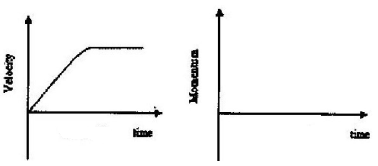
On the axes provided sketch the graph of momentum against time for the same mass (1mk) - The graph in the figure below shows the velocity of a car in the first 8 seconds as it accelerates from rest along a straight line.
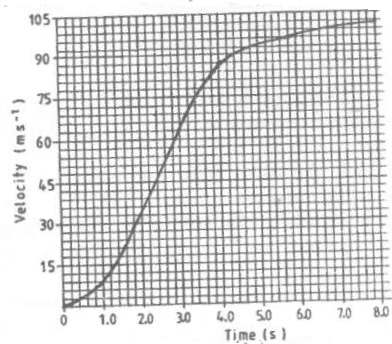
- Determine the distance traveled 3.0 seconds after the start. (3mks)
- Determine the acceleration of the car at 4.0 seconds. (2mks)
- A bomber flying horizontally at 100m/s releases a bomb from a height of 300m. Calculate:
- Time taken for the bomb to hit the ground.
- The horizontal distance traveled when hitting the ground.
- The magnitude and direction of the velocity when hitting the ground?
- An airplane is flying horizontally over a camp at 250m/s and drops a pack. How far from the camp will the pack land if the plane was flying 300m above the ground?
- An object is projected horizontally at a velocity of 40m/s from a cliff 20m high. Calculate:
- The time taken to hit the ground
- The distance from the foot of the cliff when the object hits the ground.
- A ball-bearing X is dropped vertically downwards, from the edge of a table and it takes 0.5s to hit the floor below. Another bearing Y leaves the edge of the table horizontally with a velocity of 5m/s. find:
- The time taken for bearing Y to reach the floor.
- The horizontal distance traveled by Y before hitting the floor.
- The height of the table-top above the floor level.
- A helicopter, which was ascending vertically at a steady velocity of 20m/s, released a parcel that took 20 second to reach the ground.
- State the direction in which the parcel moved immediately it was released.
- Calculate the time taken by the parcel to reach the ground from the maximum height.
- Calculate the velocity of the parcel when it strikes the ground.
- Calculate the maximum height above the ground the parcel reached.
- What was the height of the helicopter at the instant the parcel was dropped.
- A stone is thrown horizontally from a building that is 50 m high above a horizontal ground. The stone hits the ground at a point, which is 65m from the foot of the building. Calculate the initial speed of the stone.
Answers
-
- AB - ball rising to max height
BC - ball falling to ground
CDE- ball rebouncing/ changing velocity from +ve to –ve - Acceleration = gradient = 19.8 = 9.9 m/s2
- Displacement = area
= ½ x 2 x 19.8 = 19.8m - Upon hitting the ground the ball looses some energy.
- AB - ball rising to max height
-
- Time interval between any two dots = 1/50 =0.02s
Dist d1 between 1st and 2nd dots = 2.2 cm
= V1 = 0.022 m = 1.1ms-1
0.02 s
Dist d2 between 4th and 5th dots = 3.3cm, v2 = 0.033 =1.65m/s
0.02
Note: the average velocity between any two dots = the velocity of a point half way between the pts. Label the pts A.B.C.D & E label a pt x and y half way between D and E respectively (i.e. halfway in time not distance)
T x y = 0.01+ 0.02 x 2 + 0.01 = 0.06s
Therefore a = V2 – V =1.65 − 1.1 = 0.54 = 9m/s2
T 0.06 0.06 - Speed is a scalar quantity while velocity is a vector quality.
- v = u +at
0 =15 − 10t
t= 15s (to max height) therefore total time = 2 x 1.5=3s -
- Initial vertical velocity = 0, a=10, S=4m
Therefore: S= ut + 1/2 gt2
4 = 0+5t2
t = 0.8944
Range (horizontal dist) = initial vel. (constant) x time
= 12 x 0.8944
= 10.73m - Initial and final horizontal velocities are equal =12m/s
Final vertical velocity = v = u + at
v = 0 + 10 x 0.8944
v = 8.944 m/s
- Initial vertical velocity = 0, a=10, S=4m
- OA = OB therefore OAB is isosceles
Displacement is distance covered in a straight line i.e. AB since <OBA = AOB = 60 then the triangle is equilateral. So AB=AO=4m -
- t = 1/f = 1/50 = 0.02s
- 0.1s is equal to 5 time intervals
Diagram not drawn to scale (refer from the actual paper) - Average vel between - 0.02S to 0.02 = X1/0.04 (=vel at t=0s)
Similarly for 0.08 to 0.12, v2 = X2 = vel at t = 0.1s
0.04
For 0.18 to 0.22, v3 = X3 = vel at t = 0.2s
0.04
For 0.28 to 0.32, v4 = X4 = vel at t= 0.3s
0.04 - Note: The average velocities above represent the actual velocities halfway between the three dots.
Tabulating the results
Plot v against t and draw the best line of fit. Find gradient = acceleration.Time
0
0.1
0.2
0.3
Velocity (v)
V1
V2
V3
V4
-
- Initial vertical velocity = 0, a = g; s= 5m
S=ut + 1/2gt2
S = 0 + 5t2
T= 1s - Range = Uμ x t = 30 x 1 = 30m
- Vv =Uv + gt
Vv = 0 + 10 x 1 = 10m/s
- Initial vertical velocity = 0, a = g; s= 5m
-
- Plot the graph
Note: the graph is a straight line for the first 4 seconds then a curve - Velocity constant
- Draw tangents to the graph at t = 4, 5 s and t = 6.5 s. Obtains the gradients of the tangents g1 and g2 which are equal to velocities at t = 4.5 s (V1) and at t
= 6.5s (V2)
Acc = V2 - V1 ≈ 4.9m/s2
6.5 - 4.5
- Plot the graph
-
-
- acc = (change in vel/time)
a = (v - u) .
t
v = u + at.... (i) - Displacement = average vel x time
s = (u + u + at)t = ut +1/2at2 ... (ii)
2 - Square equation (i)
v2 = (u + at)2
v2 = u2 + 2aut + a2t2
Factorizing v2 = u2 + 2a (ut + 1/2at2)
but ut + 1/2at2 = s (from equ.(ii) .
v2 = u2 + 2as
- acc = (change in vel/time)
- u = 50m/s
a =2m/s2 v= 0
v2 = u2 + 2as
0 = 2500 - 4s
S= 625m
-
- mgh = 1/2mv2
1/2 v2 = gh
1/2 x 36/10 = h
h = 1.8m -
-
-
- u = 20m/s, t=2s, v=0
V = u + at
0 = 20 + a x 2
A = -10m/s
Deceleration = 10m/s2 - Distance traveled before starting to break = 0.2 x 20 = 4m
Distance moved after breaks are applied,
U=20, a=-10, v=0
v2 = u2 + 2as
0 = 400 - 20s
s = 20m
Total distance = 24m
- u = 20m/s, t=2s, v=0
-
- S = 1/2(a+b)h
h = 1/2(40+20)(25) = 750 m -

-
-
- Particle stationary/at rest.
- Increasing vel. (grad=vel)
- Particle moving at cost. vel in the opp. direction i.e. towards origin.
-
- Uv=0, S=45m, a=10m/s2 t=?
S =ut+ 1/2at2
45 = 0+5t2
t=3s - Range =50m
t=35
Um = 50/3 = 16.67m/s - Vv = Uv + at
Vv = 0 + 10 x 3
Vv = 30m/s
- Uv=0, S=45m, a=10m/s2 t=?
-
- Total distance = area bound by x-axis and the line of graph
Total distance = 2 x 12 x 2 x 20 = 40 m
Note: Since distance is scalar quantity the -ve area is taken to be +ve. - s=15, Um=300m/s, av=10m/s2, Uv=0m/s
Therefore s=ut + 1/2at2
15 = 0 + 5t2
t = √3
t=1.732s
Therefore d=UH x t=300 x 1.732 = 519.62 m -
-
- Distance = area under curve between 0 and 3.0 second.
= 120 x 3x 0.2 = 72m
Accept 70.5, 73.5, 76.5 - Acceleration = slope of graph at t = 4.0s
16 x 3
17 x 0.2 = 14.11 m/s2
- Distance = area under curve between 0 and 3.0 second.
-
- 24.45s
- 2445m
- 264.2 m/s or 67.80 to the horizontal
- 1936.5m
-
- 2s
- 80
-
- 0.5s
- 2.5m
- 1.25m
-
- Upwards
- 18s
- 180m/s
- 1620m
- 1,600m
- 20.6m/s
Join our whatsapp group for latest updates
Tap Here to Download for 50/-
Get on WhatsApp for 50/-
Download Linear Motion Questions and Answers - Physics Form 3 Topical Revision.
Tap Here to Download for 50/-
Get on WhatsApp for 50/-
Why download?
- ✔ To read offline at any time.
- ✔ To Print at your convenience
- ✔ Share Easily with Friends / Students


